
Toujeo 300 unidades/ml solostar solucion inyectable en pluma precargada
Спросите врача о рецепте на Toujeo 300 unidades/ml solostar solucion inyectable en pluma precargada

Инструкция по применению Toujeo 300 unidades/ml solostar solucion inyectable en pluma precargada
Введение
Инструкция: информация для пользователя
Туджео 300 единиц/мл SoloStar раствор для инъекций в предварительно заполненной笔
Инсулин гларгин
Каждая笔 SoloStar вводит 1-80 единиц с шагом 1 единица.
Прочитайте внимательно всю инструкцию перед началом использования этого препарата, поскольку она содержит важную информацию для вас.
- Сохраните эту инструкцию, поскольку вам может потребоваться прочитать ее снова.
- Если у вас есть какие-либо вопросы, проконсультируйтесь с вашим врачом, фармацевтом или медсестрой.
- Этот препарат был назначен только вам, и не передавайте его другим людям, даже если у них такие же симптомы, как у вас, поскольку это может нанести им вред.
- Если вы испытываете побочные эффекты, проконсультируйтесь с вашим врачом или фармацевтом, даже если это побочные эффекты, которые не указаны в этой инструкции. См. раздел 4.
Содержание инструкции
- Что такое Туджео и для чего он используется
- Что вам нужно знать перед началом использования Туджео
- Как использовать Туджео
- Возможные побочные эффекты
- Хранение Туджео
- Содержание упаковки и дополнительная информация
1. Что такое Туджео и для чего он используется
Туджео содержит инсулин, называемый «инсулин гларгин». Это модифицированный инсулин, очень похожий на человеческий инсулин.
Туджео содержит в три раза больше инсулина в 1 мл, чем стандартный инсулин, содержащий 100 единиц/мл.
Он используется для лечения сахарного диабета у взрослых, подростков и детей от 6 лет. Сахарный диабет - это заболевание, при котором ваш организм не производит достаточно инсулина для контроля уровня сахара в крови.
Туджео снижает ваш уровень сахара в крови постоянно в течение длительного периода. Он используется один раз в день. Если необходимо, вы можете изменить время инъекции, поскольку этот препарат снижает ваш уровень сахара в крови в течение длительного периода (см. раздел 3).
2. Что вам нужно знать перед началом использования Туджео
Не используйте Туджео
- если вы аллергичны к инсулину гларгину или любому другому компоненту этого препарата (указанному в разделе 6).
Предостережения и меры предосторожности
Проконсультируйтесь с вашим врачом, фармацевтом или медсестрой перед началом использования Туджео
Следуйте точно инструкциям по дозировке, контролю (анализу крови и мочи), диете и физической активности (физическому труду и упражнениям) и технике инъекции, которые были установлены с вашим врачом.
Обратите особое внимание на следующее:
- Слишком низкие уровни сахара в крови (гипогликемия). Если ваш уровень сахара в крови слишком низок, следуйте руководству по гипогликемии (см. информацию в конце этого листка).
- Если вы меняете тип, марку или производителя инсулина, вам может потребоваться изменить дозу инсулина.
- Пиоглитазон. См. «Пиоглитазон, используемый с инсулином».
- Убедитесь, что используете правильный инсулин. Были зарегистрированы ошибки при приеме лекарств из-за путаницы между инсулинами, особенно между инсулинами длительного действия и инсулинами быстрого действия. Всегда проверяйте этикетку инсулина перед каждой инъекцией, чтобы избежать путаницы между Туджео и другими инсулинами.
- Никогда не используйте шприц для извлечения Туджео из предварительно заполненной笔 SoloStar. Это делается для предотвращения ошибок дозировки и возможных передозировок, которые могут привести к снижению сахара. См. раздел 3.
- Если вы слепы или имеете плохое зрение, не используйте предварительно заполненную笔 без помощи, поскольку вы не можете прочитать окно дозировки на笔. Попросите помощи у другого человека с хорошим зрением и обученного в использовании笔. Если у вас плохое зрение, см. раздел 3.
Изменения кожи в месте инъекции
Необходимо менять место инъекции, чтобы избежать изменений кожи, таких как уплотнения под кожей. Инсулин может не работать очень хорошо, если вводится в уплотненную зону (см. «Как использовать Туджео»). Свяжитесь с вашим врачом, если вы сейчас вводите инсулин в уплотненную зону, прежде чем начать вводить в другую зону. Ваш врач может указать вам проверить уровень сахара в крови более часто и отрегулировать инсулин или дозу других антидиабетических препаратов.
Заболевания и травмы
Управление вашим диабетом может потребовать дополнительного ухода в следующих ситуациях (например, анализ крови и мочи):
- Если вы больны или получили серьезную травму. Это может увеличить ваш уровень сахара в крови (гипергликемия).
- Если вы не едите достаточно. Ваш уровень сахара в крови может снизиться слишком сильно (гипогликемия).
В большинстве случаев вам необходимо проконсультироваться с врачом. Свяжитесь с вашим врачом как можно скорее, если вы чувствуете себя больным или получили травму.
Если у вас диабет «1-го типа» и вы больны или получили травму:
- Не прекращайте принимать инсулин.
- Продолжайте принимать достаточное количество углеводов.
Всегда информируйте людей, которые занимаются вашим уходом или лечением, о том, что у вас диабет.
Лечение инсулином может вызвать производство антител к инсулину (веществ, которые действуют против инсулина) в вашем организме. Однако только в очень редких случаях это потребует изменения дозы инсулина.
Путешествия
Прежде чем отправиться в путешествие, проконсультируйтесь с вашим врачом. Вам может потребоваться обсудить с ним:
- Доступность вашего типа инсулина в стране, которую вы собираетесь посетить.
- Как получить инсулин, иглы и другие материалы.
- Как правильно хранить инсулин во время путешествия.
- График приема пищи и введения инсулина.
- Возможные эффекты смены часовых поясов.
- Риски для здоровья в странах, которые вы собираетесь посетить.
- Что делать в случае чрезвычайных ситуаций, когда вы не чувствуете себя хорошо или заболеваете.
Дети и подростки
Этот препарат не должен использоваться у детей младше 6 лет, поскольку нет опыта использования Туджео в этой возрастной группе.
Использование Туджео с другими препаратами
Информируйте вашего врача, фармацевта или медсестру, если вы принимаете, недавно принимали или можете принимать любой другой препарат.
Некоторые препараты могут изменить ваш уровень сахара в крови. Это может означать, что ваша доза инсулина должна быть изменена. Поэтому, прежде чем принимать любой препарат, спросите вашего врача, будет ли он влиять на ваш уровень сахара в крови и какие действия необходимо предпринять, если это необходимо. Вам также необходимо быть осторожным, когда вы прекращаете принимать любой препарат.
Ваш уровень сахара в крови может снизиться (гипогликемия), если вы принимаете:
- Другие препараты для лечения диабета.
- Дисопирамид - для некоторых проблем с сердцем.
- Флуоксетин - для депрессии.
- Антибиотики группы сульфонамидов.
- Фибраты - для снижения высоких уровней жира в крови.
- Ингибиторы моноаминоксидазы (ИМАО) - для депрессии.
- Ингибиторы ангиотензин-превращающего фермента (АПФ) - для проблем с сердцем или высоким кровяным давлением.
- Препараты для облегчения боли и снижения температуры, такие как пентоксифиллин, пропоксифен и салицилаты (например, ацетилсалициловая кислота).
- Пентамидин - для некоторых инфекций, вызванных паразитами. Это может вызвать слишком низкие уровни сахара в крови, за которыми могут следовать очень высокие уровни сахара в крови.
Ваш уровень сахара в крови может повыситься (гипергликемия), если вы принимаете:
- Кортикостероиды, такие как кортизон - для воспаления.
- Даназол - для эндометриоза.
- Диазоксид - для высокого кровяного давления.
- Ингибиторы протеазы - для ВИЧ.
- Мочегонные препараты - для высокого кровяного давления или задержки жидкости.
- Глюкагон - для слишком низких уровней сахара в крови.
- Изониазид - для туберкулеза.
- Соматотропин - гормон роста.
- Гормоны щитовидной железы - для проблем с щитовидной железой.
- Эстрогены и прогестагены - как противозачаточные таблетки для контроля над рождаемостью.
- Клоzapин, оланзапин и производные фенотиазина - для проблем с психическим здоровьем.
- Симпатикомиметические препараты, такие как адреналин (эпинефрин), сальбутамол и тербуталин - для астмы.
Ваш уровень сахара в крови может повыситься или снизиться, если вы принимаете:
- Бета-блокаторы или клонидин - для высокого кровяного давления.
- Соли лития - для проблем с психическим здоровьем.
Бета-блокаторы
Бета-блокаторы, такие как другие «симпатиколитические препараты» (например, клонидин, гуанетидин, резерпин - для высокого кровяного давления), могут сделать более трудным распознавание предупреждающих знаков того, что ваш уровень сахара в крови слишком низок (гипогликемия). Они даже могут скрыть или прервать первые признаки того, что ваш уровень сахара в крови слишком низок.
Пиоглитазон, используемый с инсулином
Некоторые пациенты с диабетом 2-го типа длительного течения и предыдущими заболеваниями сердца или инсультом, которые были лечены пиоглитазоном и инсулином, развили сердечную недостаточность. Сообщите вашему врачу как можно скорее, если вы испытываете симптомы сердечной недостаточности, такие как необычные трудности с дыханием или быстрое увеличение веса или локальное отекание (отек). Сообщите вашему врачу как можно скорее.
Если что-либо из вышеперечисленного относится к вам (или вы не уверены), сообщите вашему врачу, фармацевту или медсестре перед использованием Туджео.
Использование Туджео с алкоголем
Ваш уровень сахара в крови может повыситься или снизиться, если вы употребляете алкоголь. Вам необходимо проверять ваш уровень сахара в крови более часто.
Беременность и лактация
Если вы беременны или кормите грудью, считаете, что можете быть беременной или планируете стать беременной, проконсультируйтесь с вашим врачом перед использованием этого препарата. Ваша доза инсулина может потребовать изменения во время беременности и после родов. Это особенно важно для здоровья вашего ребенка, тщательного контроля вашего диабета и предотвращения гипогликемии.
Если вы кормите грудью, проконсультируйтесь с вашим врачом, поскольку вам может потребоваться отрегулировать дозу инсулина и диету.
Вождение и использование машин
Слишком низкие или слишком высокие уровни сахара в крови или проблемы со зрением могут повлиять на вашу способность управлять транспортными средствами и использовать инструменты или машины. Ваша концентрация внимания может быть нарушена. Это может быть опасно для вас и других.
Спросите вашего врача, можете ли вы управлять транспортным средством, если:
- Ваш уровень сахара в крови часто слишком низок.
- Вам трудно распознавать, когда ваш уровень сахара в крови слишком низок.
Туджео содержит натрий
Этот препарат содержит менее 1 ммоль (23 мг) натрия на дозу, что означает, что он практически «не содержит натрия».
3. Как использовать Туджео
Следуйте точно инструкциям по введению этого препарата, указанным вашим врачом. В случае сомнений проконсультируйтесь с вашим врачом, фармацевтом или медсестрой.
Хотя Туджео содержит тот же активный ингредиент, что и инсулин гларгин 100 единиц/мл, эти препараты не взаимозаменяемы. Переход от одного лечения инсулином к другому требует медицинского назначения, медицинского наблюдения и мониторинга уровня сахара в крови. Для получения более подробной информации проконсультируйтесь с вашим врачом.
Какое количество использовать
Предварительно заполненная笔 SoloStar Туджео может вводить дозы от 1 до 80 единиц за одну инъекцию с шагом 1 единица.
Окно дозировки на笔 SoloStar показывает количество единиц Туджео, которые необходимо ввести. Не изменяйте дозу.
В зависимости от вашего образа жизни, контроля уровня сахара в крови и предыдущего инсулина ваш врач скажет вам:
- Сколько Туджео вам нужно каждый день и в какое время.
- Когда проверять уровень сахара в крови и是否 необходимо проводить анализ мочи.
- Когда вам может потребоваться более высокая или более низкая доза.
Туджео - это инсулин длительного действия. Ваш врач может сказать вам, что необходимо использовать его с инсулином быстрого действия или с другими препаратами для снижения уровня сахара в крови.
Если вы используете более одного типа инсулина, всегда проверяйте, что используете правильный инсулин, проверяя этикетку инсулина перед каждой инъекцией. Были зарегистрированы ошибки при приеме лекарств из-за путаницы между инсулинами, особенно между инсулинами длительного действия и инсулинами быстрого действия. Доза «300» выделена золотым цветом на этикетке предварительно заполненной笔 SoloStar Туджео. Проконсультируйтесь с вашим врачом и фармацевтом, если у вас есть сомнения.
Многие факторы могут влиять на ваш уровень сахара в крови. Вам необходимо знать эти факторы, чтобы вы могли правильно реагировать на изменения уровня сахара в крови и предотвратить его слишком сильное повышение или снижение. Для получения более подробной информации см. раздел в конце этого листка.
Гибкость во времени введения
- Используйте Туджео один раз в день, предпочтительно в одно и то же время каждый день.
- Когда это необходимо, вы можете вводить его за 3 часа до или после обычного времени введения.
Использование у пациентов пожилого возраста (65 лет и старше)
Если вам 65 лет или более, сообщите вашему врачу, поскольку вам может потребоваться более низкая доза.
Если у вас есть проблемы с почками или печенью
Если у вас есть проблемы с почками или печенью, сообщите вашему врачу, поскольку вам может потребоваться более низкая доза.
Перед введением Туджео
- Прочитайте инструкции по использованию, указанные в этом листке.
- Если вы не следуйте инструкциям полностью, вы можете получить слишком много или слишком мало инсулина.
Как вводить
- Туджео вводится под кожу (субкутанно или «СК»).
- Вводите его в переднюю часть ваших бедер, верхнюю часть ваших рук или переднюю часть вашей талии (живота).
- Каждый день меняйте место инъекции внутри одной области инъекции. Это уменьшит риск того, что кожа станет тонкой или утолщенной (см. «Другие побочные эффекты» в разделе 4).
Чтобы предотвратить возможную передачу заболеваний,笔 инсулина никогда не должны использоваться более чем одним человеком, даже если меняется игла.
Всегда вставляйте новую стерильную иглу перед каждой инъекцией. Никогда не повторно используйте иглы. Если вы повторно используете иглу, вы увеличиваете риск блокировок и получения слишком много или слишком мало инсулина.
Утилизируйте использованную иглу в контейнере, устойчивом к проколам, или как указал ваш фармацевт или местные власти.
Не используйте Туджео
- В вену, поскольку это изменит способ его действия и может вызвать слишком сильное снижение уровня сахара в крови.
- В инсулиновой помпе.
- Если в инсулине появляются частицы. Раствор должен быть прозрачным, бесцветным и иметь водянистый вид.
Никогда не используйте шприц для извлечения Туджео из предварительно заполненной筆 SoloStar, поскольку это может привести к серьезной передозировке. См. раздел 2.
Если筆 SoloStar неисправна, это означает, что она не была хранена правильно. Если вы не уверены, что она работает правильно, или если ваш контроль уровня сахара в крови внезапно ухудшается:
- Утилизируйте筆 и используйте новую.
- Если вы считаете, что у вас есть проблемы с вашей筆, немедленно сообщите вашему врачу, фармацевту или медсестре.
Если вы используете больше Туджео, чем необходимо
Если вы ввели слишком много препарата, ваш уровень сахара в крови может снизиться слишком сильно. Проверьте ваш уровень сахара в крови и съешьте больше, чтобы предотвратить слишком сильное снижение уровня сахара в крови. Если ваш уровень сахара в крови слишком низок, см. раздел в конце этого листка.
Если вы забыли использовать Туджео
Когда это необходимо, Туджео можно вводить за 3 часа до или после обычного времени введения.
Если вы забыли принять дозу Туджео или если вы не ввели достаточно инсулина, ваш уровень сахара в крови может повыситься слишком сильно (гипергликемия):
- Не вводите двойную дозу, чтобы компенсировать пропущенные дозы.
- Проверьте ваш уровень сахара в крови и введение следующей дозы в обычное время.
- Для получения более подробной информации о лечении гипергликемии см. раздел в конце этого листка.
Если вы прекратите лечение Туджео
Не прекращайте ваше лечение без консультации с вашим врачом. Если вы это сделаете, это может привести к слишком высоким уровням сахара в крови и увеличению количества кислоты в крови (кetoацидоз).
Если у вас есть какие-либо другие вопросы о использовании этого препарата, спросите вашего врача, фармацевта или медсестру.
4. Возможные побочные эффекты
Как и все лекарства, это лекарство может вызывать побочные эффекты, хотя не все люди их испытывают.
Если вы заметите признаки того, что ваш уровень сахара в крови слишком низок (гипогликемия),действуйте немедленно, чтобы повысить уровень сахара в крови (см. рамку в конце этого листка).
Гипогликемия (низкий уровень сахара в крови) может быть очень серьезной и часто встречается во время лечения инсулином (может повлиять на более 1 из 10 человек).
Низкий уровень сахара в крови означает, что в крови не достаточно сахара.
Если ваш уровень сахара в крови упадет слишком низко, вы можете потерять сознание (обезволиться).
Серьезная гипогликемия может вызвать повреждение мозга и может быть потенциально смертельной. Для получения более подробной информации см. рамку в конце этого листка.
Тяжелые аллергические реакции(редкие, могут повлиять до 1 из 1000 человек). Признаки могут включать высыпание и зуд по всему телу, отек кожи или рта, трудности с дыханием, чувство головокружения (понижение артериального давления) с быстрым сердечным ритмом и потоотделением. Тяжелые аллергические реакции могут быть потенциально смертельными. Сообщите вашему врачу немедленно, если вы заметите признаки тяжелой аллергической реакции.
Другие побочные эффекты
Сообщите вашему врачу, фармацевту или медсестре, если вы заметите любой из следующих побочных эффектов:
- Изменения кожи в месте инъекции:
Если вы вводите инсулин слишком часто в одно и то же место, жировая ткань может уменьшиться (липоатрофия, может повлиять до 1 из 100 человек) или стать более толстой (липогипертрофия), (может повлиять до 1 из 10 человек). Также могут образовываться бугорки под кожей из-за накопления белка, называемого амилоидом (кутаная амилоидоз; неизвестно, как часто это происходит). Инсулин может не работать очень хорошо, если вводить его в приподнятую зону. Меняйте место инъекции, чтобы помочь избежать этих изменений кожи.
Частые:могут повлиять до 1 из 10 человек
- Кожные реакции и аллергические реакции в месте инъекции: признаки могут включать покраснение, сильную боль при введении, зуд, крапивницу, отек или воспаление. Эти реакции могут распространиться вокруг места инъекции. Большинство легких реакций на инсулин обычно проходят в течение нескольких дней или недель.
Редкие:могут повлиять до 1 из 1000 человек
- Глазные реакции: значительные изменения контроля сахара в крови (улучшение или ухудшение) могут повлиять на ваше зрение. Если у вас есть глазное расстройство, связанное с диабетом, называемое "пролиферативной ретинопатией", кризисы низкого уровня сахара в крови могут вызвать временную потерю зрения.
- Отек икр и лодыжек, вызванный временным накоплением воды в организме.
Очень редкие:могут повлиять до 1 из 10 000 человек
- Изменение вкуса (дисгевзия).
- Мышечная боль (миалгия).
Сообщите вашему врачу, фармацевту или медсестре, если вы заметите любой из вышеуказанных побочных эффектов.
Сообщение о побочных эффектах
Если вы испытываете любой побочный эффект, проконсультируйтесь с вашим врачом, фармацевтом или медсестрой, даже если это возможные побочные эффекты, которые не перечислены в этом листке. Вы также можете сообщить об этом напрямую через национальную систему уведомления, включенную в Приложение V. Сообщая о побочных эффектах, вы можете внести свой вклад в предоставление более полной информации о безопасности этого лекарства.
5. Хранение Туджео
Храните это лекарство в недоступном для детей месте.
Не используйте это лекарство после даты истечения срока годности, указанной на коробке и этикетке ручки после CAD. Дата истечения срока годности - последний день месяца, указанного.
До первого использования
Храните в холодильнике (при температуре от 2°C до 8°C).
Не замораживайте и не размещайте рядом с морозильной камерой или охладителем.
Храните ручку в наружной упаковке, чтобы защитить ее от света.
После первого использования или если оно хранится в качестве резерва
Не храните ручку в холодильнике. Ручку можно хранить в течение максимум 6 недель при температуре ниже 30°C, защищая от прямого тепла или прямого света. Утилизируйте ручку после этого периода. Не оставляйте вашу инсулин в машине в исключительно жаркий или холодный день. Когда вы не используете ручку, всегда надевайте на нее колпачок, чтобы защитить ее от света.
Лекарства не должны выбрасываться в канализацию или мусор. Спросите вашего фармацевта, как утилизировать упаковку и лекарства, которые вам больше не нужны. Таким образом, вы поможете защитить окружающую среду.
6. Содержание упаковки и дополнительная информация
Состав Туджео
- Активное вещество - инсулин гларгин. Каждый мл раствора содержит 300 единиц инсулина гларгина (эквивалентно 10,91 мг). Каждая ручка содержит 1,5 мл инъекционного раствора, эквивалентного 450 единицам.
Другие компоненты: хлорид цинка, метакрезол, глицерол, вода для инъекционных препаратов, гидроксид натрия (см. раздел 2 «Туджео содержит натрий») и соляная кислота (для регулирования pH).
Внешний вид Туджео и содержание упаковки
Туджео - прозрачный бесцветный раствор.
Каждая ручка содержит 1,5 мл инъекционного раствора (эквивалентно 450 единицам).
Упаковки по 1, 3, 5 и 10 предзагруженных ручек.
Возможно, не все размеры упаковок будут продаваться.
Владелец разрешения на маркетинг и ответственный за производство
Sanofi-Aventis Deutschland GmbH, D-65926 Франкфурт-на-Майне, Германия.
Для получения дополнительной информации о этом лекарственном средстве можно обратиться к местному представителю владельца разрешения на маркетинг:
Бельгия/Белгique/Бельгия Sanofi Belgium Тел.: +32 (0)2 710 54 00 | Литва UAB sanofi-aventis Литва Тел.: +370 5 2755224 |
Болгария SANOFI BULGARIA EOOD Тел.: +359 (0)2 970 53 00 | Люксембург/Люксбург Sanofi Belgium Тел.: +32 (0)2 710 54 00 (Бельгия/Бельгия) |
Чехия sanofi-aventis, s.r.o. Тел.: +420 233 086 111 | Венгрия sanofi-aventis zrt., Венгрия Тел.: +36 1 505 0050 |
Дания Sanofi A/S Тел.: +45 45 16 70 00 | Мальта Sanofi S.p.A Тел.: 39 02 39394275 |
Германия Sanofi-Aventis Deutschland GmbH Тел.: 0800 52 52 010 Тел. из-за рубежа: +49 69 305 21 131 | Нидерланды sanofi-aventis Netherlands B.V. Тел.: +31 20 245 4000 |
Эстония sanofi-aventis Эстония OÜ Тел.: +372 627 34 88 | Норвегия sanofi-aventis Норвегия AS Тел.: +47 67 10 71 00 |
Греция sanofi-aventis AEBE Тел.: +30 210 900 16 00 | Австрия sanofi-aventis GmbH Тел.: +43 1 80 185 – 0 |
Испания sanofi-aventis, S.A. Тел.: +34 93 485 94 00 | Польша sanofi-aventis Sp. z o.o. Тел.: +48 22 280 00 00 |
Франция sanofi-aventis Франция Тел.: 0 800 222 555 Звонок из-за рубежа: +33 1 57 63 23 23 | Португалия Sanofi - Продукты Фармацевтики, Lda Тел.: +351 21 35 89 400 |
Хорватия sanofi-aventis Хорватия d.o.o. Тел.: +385 1 600 34 00 | Румыния Sanofi Romania SRL Тел.: +40 (0) 21 317 31 36 |
Ирландия sanofi-aventis Ирландия Ltd. T/A SANOFI Тел.: +353 (0) 1 403 56 00 | Словения sanofi-aventis d.o.o. Тел.: +386 1 560 48 00 |
Исландия Vistor hf. Тел.: +354 535 7000 | Словакия sanofi-aventis Pharma Словакия s.r.o. Тел.: +421 2 33 100 100 |
Италия Sanofi S.p.A. Тел.: 800 131212 (вопросы технического характера) 800 536389 (другие вопросы) | Финляндия Sanofi Oy Тел.: +358 (0) 201 200 300 |
Кипр sanofi-aventis Кипр Ltd. Тел.: +357 22 871600 | Швеция Sanofi AB Тел.: +46 (0)8 634 50 00 |
Латвия sanofi-aventis Латвия SIA Тел.: +371 67 33 24 51 | Великобритания Sanofi Тел.: +44 (0) 845 372 7101 |
Дата последнего пересмотра этого листка:
Подробная информация о этом лекарственном средстве доступна на сайте Европейского агентства по лекарственным средствам: http://www.ema.europa.eu.
ГИПЕРГЛИКЕМИЯ И ГИПОГЛИКЕМИЯ Если вы принимаете инсулин, всегда должны иметь при себе:
Гипергликемия (высокий уровень сахара в крови) Если ваш уровень сахара в крови слишком высок (гипергликемия), возможно, вы не ввели достаточно инсулина. Причины, по которым может произойти гипергликемия Некоторые примеры:
Признаки предупреждения гипергликемии Жажда, увеличение необходимости мочеиспускания, усталость, сухость кожи, покраснение лица, потеря аппетита, низкое кровяное давление, быстрый сердечный ритм и наличие глюкозы и кетоновых тел в моче. Боль в животе, глубокое и быстрое дыхание, чувство сонливости или обморок (потеря сознания) могут быть признаками серьезного состояния (кетоацидоз), вызванного недостатком инсулина. Что делать, если вы испытываете гипергликемию?
Гипогликемия (низкий уровень сахара в крови) Если ваш уровень сахара в крови слишком низок, вы можете потерять сознание. Тяжелая гипогликемия может вызвать сердечный приступ или повреждение мозга и может поставить под угрозу вашу жизнь. Вы должны научиться распознавать признаки, которые указывают на то, что ваш уровень сахара в крови снижается, чтобы вы могли принять необходимые меры, чтобы ситуация не ухудшилась. Причины, по которым может произойти гипогликемия Некоторые примеры:
Также более вероятно, что произойдет гипогликемия, если:
Признаки предупреждения гипогликемии Первые признаки обычно появляются в вашем теле. Примеры признаков, которые указывают на то, что ваш уровень сахара в крови снижается слишком сильно или слишком быстро, являются: пот, влажная и липкая кожа, тревога, быстрый и нерегулярный сердечный ритм, высокое кровяное давление и сердцебиение. Эти признаки обычно появляются до того, как появятся признаки низкого уровня сахара в мозге. Признаки в вашем мозге включают: головную боль, чувство сильного голода, тошноту, рвоту, чувство усталости, сонливость, агитацию, проблемы со сном, агрессивное поведение, трудности с концентрацией внимания, снижение реакции, депрессию, чувство путаницы, трудности с речью (иногда, полную потерю речи), изменение зрения, тремор, невозможность двигаться (паралич), онемение и покалывание в руках или руках, чувство головокружения, потеря самообладания, невозможность заботиться о себе, судороги, потеря сознания. Ситуации, в которых признаки предупреждения гипогликемии могут быть менее ясными: Первые признаки предупреждения гипогликемии могут измениться, уменьшиться или отсутствовать, если:
В этих случаях вы можете испытать тяжелую гипогликемию (и даже потерять сознание) до того, как вы узнаете, что происходит. Всегда знакомьтесь с вашими признаками предупреждения. Если необходимо, вам может потребоваться чаще проводить анализ сахара в крови. Это может помочь выявить легкие эпизоды гипогликемии. Если вам трудно распознавать ваши признаки предупреждения, вы должны избегать ситуаций (например, вождения автомобиля), которые могут поставить вас или других людей под угрозу в результате гипогликемии. Что делать, если вы испытываете гипогликемию?
Спросите вашего врача или медсестру, если вы не уверены, что вам следует есть. С Туджео восстановление после снижения сахара в крови может быть задержано больше, поскольку оно имеет длительное действие.
Что должны делать другие люди, если у вас гипогликемия? Сообщите вашим близким, друзьям и людям, которые находятся рядом с вами, что вам нужна медицинская помощь в случае, если вы не можете глотать или если вы теряете сознание. Вам может потребоваться инъекция глюкозы или глюкагона (лекарство, которое увеличивает уровень сахара в крови). Эти инъекции оправданы даже в том случае, если вы не уверены, что у вас гипогликемия. Рекомендуется проанализировать ваш уровень сахара в крови сразу после приема глюкозы, чтобы подтвердить, что у вас действительно гипогликемия. |
Туджео 300 единиц/мл инъекционный раствор в предзагруженной ручке (SoloStar)
ИНСТРУКЦИИ ПО ПРИМЕНЕНИЮ
Прочитайте это сначала
Туджео SoloStar содержит 300 единиц/мл инсулина гларгинав предзагруженной ручке объемом 1,5 мл
- Никогда не повторно используйте иглы. Если вы это сделаете, вы можете не получить необходимую дозу (недостаточная доза) или получить слишком много (переизбыток), поскольку игла может быть заблокирована.
- Никогда не используйте шприц для извлечения инсулина из вашей ручки. Если вы это сделаете, вы можете извлечь слишком много инсулина. Градуировка на большинстве шприцев предназначена только для неконцентрированного инсулина.
Важная информация
Никогда не делитесь своей ручкой - она предназначена только для вас.
Никогда не используйте свою ручку, если она повреждена или если вы не уверены, что она работает правильно.
Всегда проводите тест на безопасность.
Всегда носите с собой ручку и иглы запаса на случай, если они потеряются или перестанут работать.
Учиться вводить
- Спросите вашего врача, фармацевта или медсестру, как вводить инсулин, прежде чем использовать свою ручку.
- Попросите о помощи, если у вас есть проблемы с обращением с вашей ручкой, например, если у вас проблемы со зрением.
- Прочитайте все эти инструкции, прежде чем использовать свою ручку. Если вы не выполните все эти инструкции, вы можете получить слишком много инсулина или слишком мало.
Нужна ли вам помощь?
Если у вас есть вопросы о вашей ручке или диабете, спросите вашего врача, фармацевта или медсестру или позвоните по номеру sanofi-aventis, указанному в начале этого листка.
Дополнительные предметы, которые вам понадобятся:
- новая стерильная игла (см. ШАГ 2).
- контейнер, устойчивый к проколам, для использованных игл и ручек.
Места для инъекций
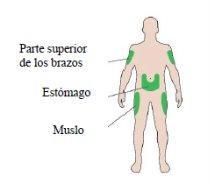
Ознакомьтесь с вашей ручкой

- Вы не увидите поршень, пока не введете несколько доз.
ШАГ 1: Проверьте свою ручку
Выньте новую ручку из холодильника не менее чем за 1 час до инъекции. Введение инсулина в холодном состоянии более болезненно.
АПроверьте название и дату истечения срока годности на этикетке вашей ручки.
- Убедитесь, что у вас правильный инсулин. Это особенно важно, если у вас есть другие ручки.
- Не используйте ручку после даты истечения срока годности.

БСнимите колпачок с ручки.

ВПроверьте, что инсулин прозрачный.
- Не используйте ручку, если инсулин мутный, имеет цвет или содержит частицы.
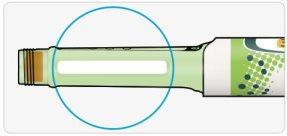
ШАГ 2: Установите новую иглу
Всегда используйте новую стерильную иглу для каждой инъекции. Это поможет предотвратить блокировку игл, загрязнение и инфекции.
Используйте только иглы, совместимые с Туджео (например, иглы BD, Ypsomed Artsana или Owen Mumford).
АВозьмите новую иглу и снимите защитный колпачок.

БДержите иглу прямо и завинтите ее в ручку до тех пор, пока она не будет зафиксирована. Не перетягивайте.
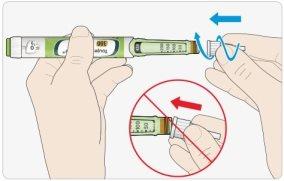
ВСнимите внешний колпачок с иглы. Сохраните его для дальнейшего использования.
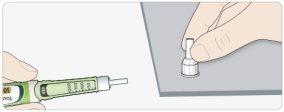
ГСнимите внутренний колпачок с иглы и выбросьте его.

Обращение с иглами
- Будьте осторожны при обращении с иглами, чтобы избежать травм от прокола и перекрестного загрязнения.
ШАГ 3: Проведите тест на безопасность
Всегда проводите тест на безопасность перед каждой инъекцией, чтобы:
- проверить, что ваша ручка и игла работают правильно.
- убедиться, что вы получаете правильную дозу инсулина.
АВыберите 3 единицы, повернув селектор дозы до тех пор, пока маркер дозы не окажется между отметками 2 и 4.
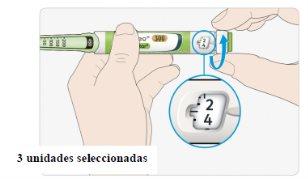
БНажмите кнопку инъекции до конца.
- Если инсулин выходит из кончика иглы, ваша ручка работает правильно.
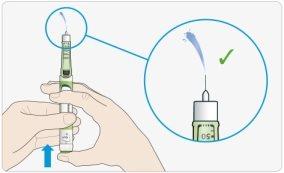
Если инсулин не выходит:
- Возможно, вам потребуется повторить этот шаг до 3 раз, прежде чем вы увидите выход инсулина.
- Если инсулин не выходит после третьего раза, возможно, игла заблокирована. Если это произойдет:
- измените иглу (см. ШАГ 6 и ШАГ 2),
- затем повторите тест на безопасность (ШАГ 3).
- Не используйте свою ручку, если инсулин не выходит из кончика иглы. Используйте новую ручку.
- Не используйте шприц для извлечения инсулина из вашей ручки.
Если вы видите воздушные пузырьки
- Возможно, вы увидите воздушные пузырьки. Это нормально; они не причинят вам вреда.
ШАГ 4: Выберите дозу
Никогда не выбирайте дозу и не нажимайте кнопку инъекции, пока игла не будет установлена, поскольку это может повредить вашу ручку.
АУбедитесь, что игла установлена и что доза установлена на «0».

БПоверните селектор дозы, пока маркер дозы не совпадет с вашей дозой.
- Если вы превысите свою дозу, вы можете повернуть назад.
- Если в вашей ручке не осталось достаточно единиц, чтобы вы могли ввести свою дозу, селектор дозы остановится на количестве единиц, которое осталось.
- Если вы не можете выбрать полную назначенную дозу, разделите дозу на две инъекции или используйте новую ручку.
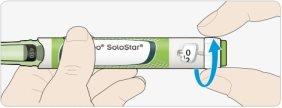
Как читать окно дозы
Четные числа указаны на той же линии, что и маркер дозы:

Выбрано 30 единиц
Нечетные числа указаны как линия между четными числами:

Выбрано 29 единиц
Единицы инсулина в вашей ручке
- Ваша ручка содержит в общей сложности 450 единиц инсулина. Вы можете выбрать дозы от 1 до 80 единиц с шагом 1 единица. Каждая ручка содержит более одной дозы.
- Вы можете увидеть, сколько единиц осталось, если посмотрите, где находится поршень на шкале инсулина.
ШАГ 5: Ввести дозу
Если вам трудно нажать кнопку инъекции, не заставляйте ее, так как это может повредить вашу ручку. Посмотрите следующее для получения помощи.
АВыберите место инъекции, как показано на рисунке.
БВставьте иглу в кожу, как вам показал ваш врач, фармацевт или медсестра.
- Еще не нажимайте кнопку инъекции.

ВПоместите большой палец на кнопку инъекции. Нажмите ее до конца и удерживайте.
- Не нажимайте кнопку под углом: ваш большой палец может заблокировать селектор дозы и не позволить ему повернуться.
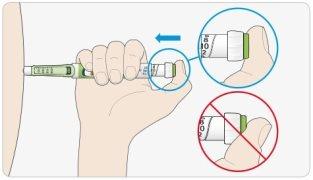
ГУдерживайте кнопку инъекции и, когда увидите «0» в окне дозы, медленно считайте до 5.
- Таким образом, вы убедитесь, что получите полную дозу.
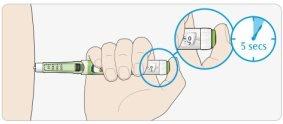
ДПосле того, как вы удержали кнопку и медленно посчитали до 5, отпустите кнопку инъекции. Затем удалите иглу из кожи.
Если вам трудно нажать кнопку:
- Замените иглу (см. ШАГ 6 и ШАГ 2) и затем выполните тест безопасности (см. ШАГ 3).
- Если вам все еще трудно нажать кнопку, используйте новую ручку.
- Не используйте шприц для извлечения инсулина из вашей ручки.
ШАГ 6: Удалить иглу
Будьте осторожны при обращении с иглами, чтобы избежать травм от уколов и перекрестного заражения.
Не надевайте обратно внутреннюю крышку иглы.
АНаденьте внешнюю крышку иглы и используйте ее, чтобы вывернуть иглу из ручки.
- Чтобы уменьшить риск случайных уколов, никогда не надевайте внутреннюю крышку.
- Если вашу инъекцию выполняет другой человек или если вы выполняете инъекцию другому человеку, необходимо проявлять особую осторожность при удалении или утилизации иглы.
- Следуйте мерам безопасности для удаления и утилизации игл (свяжитесь с вашим врачом, фармацевтом или медсестрой), чтобы уменьшить риск случайных уколов и передачи инфекционных заболеваний.
БУтилизируйте использованную иглу в контейнере, устойчивом к проколам, или так, как указал ваш фармацевт или местные власти.
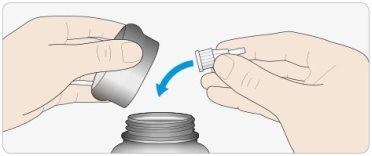
ВНаденьте крышку ручки обратно.
- Не возвращайте ручку в холодильник.

Использование
- Используйте свою ручку не более 6 недель после первого использования.
Как хранить свою ручку
До первого использования
- Храните новые ручки в холодильнике при температуре от 2°C до 8°C.
- Не замораживайте.
После первого использования
- Храните свою ручку при комнатной температуре, ниже 30 °C.
- Не возвращайте свою ручку в холодильник.
- Не храните свою ручку с иглой.
- Храните свою ручку с крышкой.
Как ухаживать за своей ручкой
Обращайтесь с ручкой осторожно
- Не роняйте свою ручку и не ударяйте ее о твердые поверхности.
- Если вы считаете, что ваша ручка может быть повреждена, не пытайтесь ее отремонтировать, используйте новую.
Защитите свою ручку от пыли и грязи
- Вы можете очистить внешнюю поверхность своей ручки влажной тканью. Не замачивайте, не мойте и не смазывайте свою ручку, так как это может повредить ее.
Утилизация своей ручки
- Удалите иглу перед утилизацией своей ручки.
- Утилизируйте свою использованную ручку так, как указал ваш медицинский работник или местные власти.

Сколько стоит Toujeo 300 unidades/ml solostar solucion inyectable en pluma precargada в Испании в 2025 году?
Средняя цена на Toujeo 300 unidades/ml solostar solucion inyectable en pluma precargada в ноябрь, 2025 года составляет около 50.63 евро. Финальная стоимость может зависеть от региона, конкретной аптеки и рецептурного статуса. Для точной информации лучше проверить онлайн или в ближайшей аптеке.
- Страна регистрации
- Средняя цена в аптеках50.63 EUR
- Активное вещество
- Требуется рецептДа
- Производитель
- Информация носит справочный характер и не является медицинской рекомендацией. Перед приемом любых препаратов проконсультируйтесь с врачом. Oladoctor не несет ответственности за медицинские решения, принятые на основе этого контента.
- Аналоги Toujeo 300 unidades/ml solostar solucion inyectable en pluma precargadaФорма выпуска: ИНЪЕКЦИОННЫЙ РАСТВОР, 100 ЕД/млАктивное вещество: инсулин гларгинПроизводитель: Eli Lilly Nederland B.V.Требуется рецептФорма выпуска: ИНЪЕКЦИОННЫЙ РАСТВОР, НеизвестноАктивное вещество: инсулин гларгинПроизводитель: Sanofi-Aventis Deutschland GmbhТребуется рецептФорма выпуска: ИНЪЕКЦИОННЫЙ, НеизвестноАктивное вещество: инсулин гларгинПроизводитель: Sanofi-Aventis Deutschland GmbhТребуется рецепт
Аналоги Toujeo 300 unidades/ml solostar solucion inyectable en pluma precargada в других странах
Лучшие аналоги с тем же действующим веществом и терапевтическим эффектом.
Аналог Toujeo 300 unidades/ml solostar solucion inyectable en pluma precargada в Украина
Врачи онлайн по Toujeo 300 unidades/ml solostar solucion inyectable en pluma precargada
Консультация по дозировке, побочным эффектам, взаимодействиям, противопоказаниям и продлению рецепта на Toujeo 300 unidades/ml solostar solucion inyectable en pluma precargada – по решению врача и с учетом местных правил.














